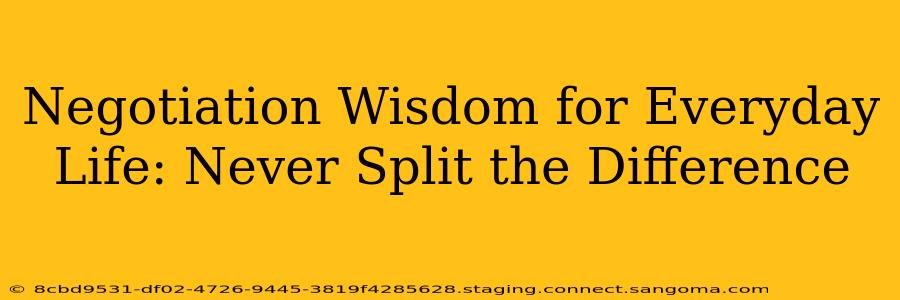Chris Voss's "Never Split the Difference" isn't just a negotiation book; it's a guide to navigating the complexities of communication and persuasion in everyday life. This isn't about aggressively winning every argument; it's about building rapport, understanding underlying needs, and achieving mutually beneficial outcomes. Voss, a former FBI hostage negotiator, reveals the tactical strategies he used to defuse high-stakes situations, applicable to everything from salary negotiations to resolving conflicts with family members. This post will delve into the core principles, answering some common questions surrounding this powerful approach.
What is the Core Idea Behind "Never Split the Difference"?
The central concept revolves around understanding the emotional landscape of negotiation. Voss emphasizes that successful negotiation isn't about finding a middle ground ("splitting the difference") but about understanding the other party's motivations, fears, and aspirations. By actively listening and employing specific tactical communication techniques, you can guide the conversation towards a solution that satisfies everyone involved. It's about collaboration, not confrontation.
How Can I Use "Never Split the Difference" in My Daily Life?
The book's principles are remarkably adaptable to everyday situations. Consider these examples:
-
Negotiating a salary: Instead of stating your desired salary upfront, ask open-ended questions to understand the company's budget and their perception of your value. This allows you to tailor your request to their constraints while highlighting your worth.
-
Resolving a conflict with a friend or family member: Focus on empathetic listening, acknowledging their feelings, and finding common ground. Instead of immediately defending your position, try to understand their perspective.
-
Buying a car: Employ tactical empathy to understand the seller's needs and motivations. This knowledge can inform your negotiating strategy, allowing you to create a win-win situation.
What are the Key Tactical Communication Techniques in "Never Split the Difference"?
Voss outlines several key techniques:
-
Tactical Empathy: This isn't about agreeing with the other person; it's about understanding and acknowledging their perspective. Phrases like "It sounds like..." or "I hear you saying..." help demonstrate empathy.
-
Labeling: Identifying and naming the other person's emotions ("It sounds like you're feeling frustrated...") helps to validate their feelings and de-escalate tension.
-
Calibrated Questions: These are open-ended questions designed to elicit information and guide the conversation towards a favorable outcome. Avoid "yes/no" questions; instead, use questions that encourage the other party to explain their reasoning.
-
Mirroring: Subtly mirroring the other person's tone and language can build rapport and create a sense of connection.
What are Some Common Mistakes to Avoid in Negotiation?
Many common negotiation mistakes stem from a lack of empathy and understanding. Avoid these pitfalls:
-
Focusing solely on your own needs: Ignoring the other party's perspective leads to stalemates and resentment.
-
Jumping to conclusions: Actively listen and avoid making assumptions about the other person's intentions.
-
Being overly aggressive: An aggressive approach often backfires, creating defensiveness and hindering progress.
-
Failing to prepare: Thorough preparation, including understanding your own needs and researching the other party, is crucial for a successful negotiation.
How Can I Practice the Techniques in "Never Split the Difference"?
The best way to practice is to start small. Try using these techniques in everyday conversations, such as negotiating a price at a flea market or resolving a minor disagreement with a colleague. As you gain confidence, you can apply these techniques to more significant negotiations.
Is "Never Split the Difference" Applicable to All Negotiation Scenarios?
While the principles are broadly applicable, some situations require a different approach. High-stakes negotiations, involving legal or ethical considerations, may necessitate the involvement of legal counsel or other professionals. However, the core principles of empathy, active listening, and strategic communication remain valuable in virtually any negotiation context.
By mastering the principles outlined in "Never Split the Difference," you can transform your approach to negotiation, improving your outcomes in both personal and professional settings. It’s not about winning at all costs; it's about finding creative solutions that benefit everyone involved.

